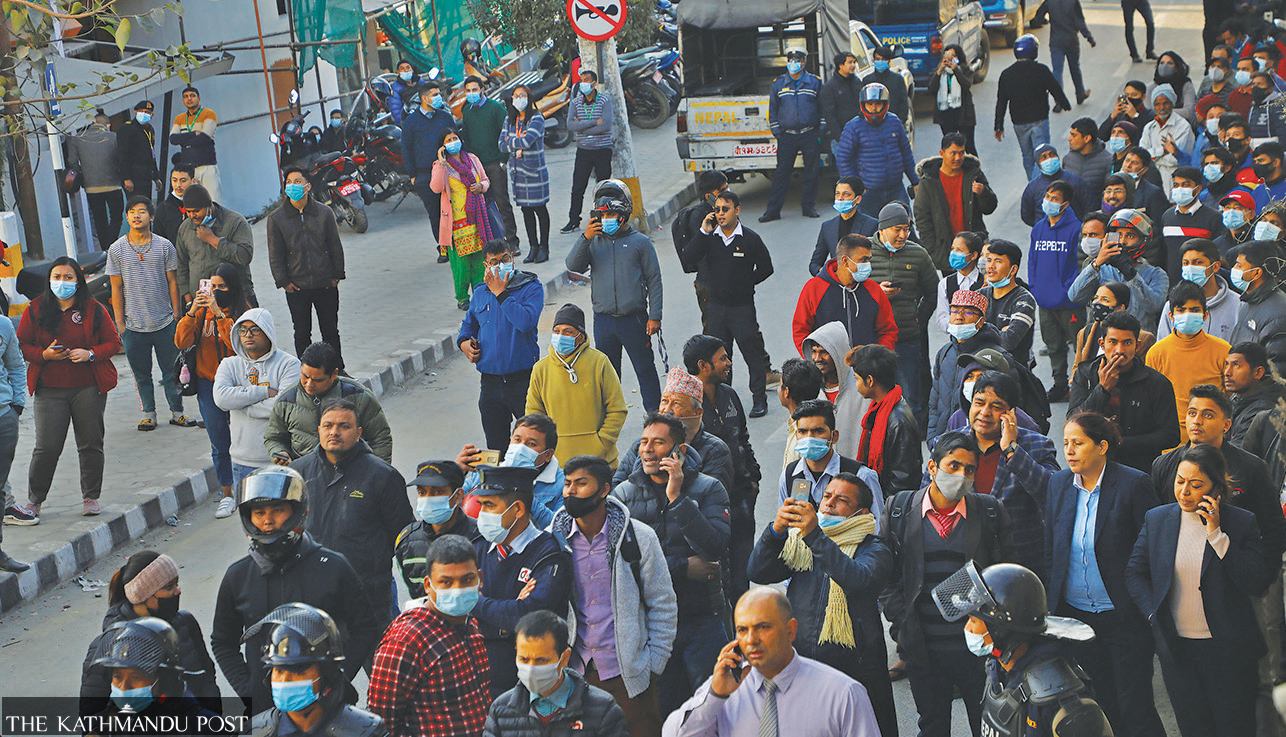Health
Warning signs of spread of Omicron as tests find S-gene missing
Public health experts say there is no room for letting guard down, especially when the new variant could create havoc.
Arjun Poudel
A particular gene has been found missing in a significant number of coronavirus infected people, mostly returning from abroad, authorities say, warning of a surge in Omicron cases in the country.
“We have found S-gene dropout in several infected people,” Dr Sangita Mishra, spokesperson for the Ministry of Health and Population, told the Post. “We have asked laboratories to send swab samples of such infected people, whose S-gene is missing, to Kathmandu for whole-genome sequencing.”
The World Health Organisation says S-gene is not present in Omicron as a result of multiple mutations the variant has undergone and is considered a marker to identify the latest iteration of the coronavirus.
“One of the target genes is not detected [called S-gene dropout or S-gene target failure] and this test can therefore be used as a marker for this variant, pending sequencing confirmation,” stated the UN health body.
Concerns over a spike in Omicron cases have grown in Nepal, which was battered by the Delta variant last in April, as test positivity rate on the people returning from India has also gone up significantly of late.
India has recorded more than 1,500 cases of the Omicron variant as of Sunday. The fast spreading variant has reached 23 states of the country. India recorded 27,553 new Covid-19 cases and 284 deaths on Sunday.
At least three cases of Omicron have been confirmed in Nepal so far, but all three infected persons have already tested negative.
Public health experts say there is no chance to let the guard down, especially when S-gene target failure is being reported.
“We have found S-gene dropout in a significant number of people, which shows that we are on the verge of an Omicron outbreak,” an official at the Department of Health Services, told the Post, asking not to be named because he was not authorised to speak to the media.
“We have been closely monitoring some infected people, who are suspected of having been infected with the Omicron variant, and people who came in their close contact.”
In neighbouring India, scientists have predicted that the Omicron-driven third wave could peak in February, just the way the Delta-triggered second wave had devastated the country last year around the same time.
Nepal witnessed the second coronavirus wave weeks after India faced the crisis.
But this time, experts say warning signs are already there.
“If we follow the trend of infection rate in India and cases of Omicron, a massive surge will start here in about two weeks,” Dr Biraj Karmacharya, an epidemiologist, told the Post. “Infection data from the districts bordering India show that new cases have already started to surge in Nepal.”

Amid the Omicron threat, there, however, are some statistics emerging from some countries which are assuaging.
Despite its high transmissibility, the severity and deaths caused by Omicron have been found to be less, with no hospitalisation needed in most cases.
South Africa, which first reported the new variant in late November, is reporting a much lower rate of hospital admissions.
According to a Bloomberg report, only 1.7 percent of the identified Covid-19 cases were admitted to hospital in the second week of infections in the fourth wave, compared to 19 percent in the same week of the third Delta-driven wave.
Leading infectious disease expert Anthony Fauci on Wednesday said that preliminary studies so far indicate that the Omicron coronavirus variant is less likely to cause severe disease as Delta.
He detailed a report from South Africa showing that those who were hospitalised during the Omicron wave compared to previous coronavirus waves were less likely to require intensive care or supplemental oxygen. He also pointed to a preliminary analysis from the UK that found that the “risk of hospitalisation alone with Omicron was 40 percent of that for Delta.”
Tedros Adhanom, director general of the World Health Organisation, however, said last week the Delta and Omicron are twin threats that are driving up cases to record numbers, which again is leading to spikes in hospitalisations and deaths.
“I am highly concerned that Omicron being more transmissible, circulating at the same time as Delta—is leading to a tsunami of cases,” said Tedros on December 29 during WHO’s media briefing. “This is and will continue to put immense pressure on exhausted health workers and health systems on the brink of collapse and again disrupting lives and livelihoods.”
Public health experts in Nepal say the virus, since its emergence in late 2019, has behaved differently in different countries, and Nepal should make its own preparations.
Even when Europe was brought down to its knees by the virus during the first wave, Nepal was somewhat unscathed, prompting authorities to maintain a lackadaisical approach. Ministers, including then prime minister KP Sharma Oli, downplayed the virus threat until the second wave led to a devastating crisis. At least 6,000 people died and hundreds of thousands were infected during two months of the second wave.
Public health experts and doctors say preventive measures must be taken almost immediately.
They have warned that the next epicenter of the Covid-19 outbreak could be schools.
“Schools must be shut immediately,” said Karmacharya, who also heads the Department of Community Programme at Dhulikhel Hospital. “It is difficult to enforce health safety measures in schools.”
Doctors say unvaccinated populations are at high risk of infection and severity. As of Sunday, 10,496,401 people or 34.6 percent of the total population have been fully vaccinated.
“Over 65 percent of the total population is still not vaccinated fully and over 47 percent of the total population has not received even the first dose,” said Dr Sher Bahadur Pun, chief of the Clinical Research Unit at the Sukraraj Tropical and Infectious Disease Hospital, Teku. “Those populations who have not been vaccinated yet and those having compromised immunity are at high risk of severity if the third wave strikes.”
Nepal has already started vaccinating children aged 12 to 17 years. Some children from 20 districts including three districts of Kathmandu Valley have been immunised with the Pfizer-BioNTech Covid-19 vaccine and around 1.7 million children from 57 other districts have been immunised with Moderna.
The National Immunisation Advisory Committee has recommended Covid-19 vaccine for children between five and 11.
The Ministry of Health and Population had planned to inoculate 500,000 people a day but vaccination data show that only around one fifth of the targeted population is vaccinated. On Sunday, 133,812 people were vaccinated.
Now amid the Omicron threat, the focus is on whole-genome sequencing.
The National Public Health Laboratory has the capacity to carry out whole-genome sequencing, but it can perform only around a few dozen genome sequencing tests in a month.
A private laboratory and laboratories of Kathmandu University and Tribhuvan University also can perform whole-genome sequencing. Since testing is costly, authorities concerned have not utilised the capacity of all laboratories.
“Without carrying out whole-genome sequencing, Omicron cases cannot be confirmed and we all know our capacity to carry out whole-genome sequencing,” Pun told the Post. “Many people may not undergo tests after an Omicron infection, as the symptoms are similar to the common cold.”




 9.12°C Kathmandu
9.12°C Kathmandu













%20(1).jpg&w=300&height=200)
